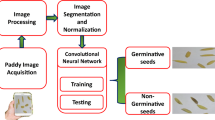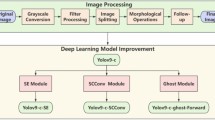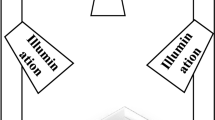Abstract
The identification of germ integrity is very important for the study of germ rice grains. However, the traditional algorithms lack to achieve better recognition results. This article proposes a specific germ integrity detection model that improves the inception-resnet v1 model and adopts topological structure branch of inception-v4. The proposed model dilates the convolution based on the original model that gives an explicit description of image features for germ rice. The proposed scheme achieves the better approximation of abstract representations for potential space. Simultaneously, this paper is based on color image features for germ rice to identify its image location. Afterward, the rice germ gathered in the training will be unified its location by image rotation in accordance with the location information of germ. The proposed model is increasing the identification precision of rice germ integrity. It further strengthens the training of germ detail features. The experiment result shows that comprehensive recognition accuracy in this paper is up to 90.43%, compared with other traditional recognition methods, the algorithm accuracy has highly improved.

















Similar content being viewed by others
Explore related subjects
Discover the latest articles, news and stories from top researchers in related subjects.References
Chen C, Liu MY, Tuzel O et al (2016) R-CNN for small object detection. In: Asian conference on computer vision. Springer, Cham, pp 214–230
Courtois F, Faessel M, Bonazzi C (2010) Assessing breakage and cracks of parboiled rice kernels by image analysis techniques. Food Control 21(4):567–572
Dong C, Loy CC, He K, TangX (2014) Learning a deep convolutional network for image super-resolution. In: Computer vision–ECCV 2014. Springer, pp 184–199
Fu C, Liu W, Ranga A, Tyagi A Berg A (2017) Dssd: deconvolutional single shot detector. arXiv:1701. 06659
Girshick R, Donahue J, Darrell T, MalikJ (2014a) Rich feature hierarchies for accurate object detection and semantic segmentation. In: Proceedings of the IEEE conference on computer vision and pattern recognition (CVPR)
Girshick R, Donahue J, Darrell T, Malik J (2014b) Rich feature hierarchies for accurate object detection andsemantic segmentation. In: Proceedings of the IEEE conference on computer vision and pattern recognition (CVPR), pp 580–587
Haque MF, Lim H-Y, Kang D-S (2019) Object detection based on VGG with resnet network. In: Proc. 18th annu. int. conf. electron. inf. commun. (ICEIC), Auckland, New Zealand, pp 1–3
Ioffe S, SzegedyC (2015) Batch normalization: accelerating deep network training by reducing internal covariate shift. In: Proceedings of the 32nd international conference on machine learning, pp 448–456
Kong T, Yao A, Chen Y et al (2016) Hypernet: towards accurate region proposal generation and joint object detection. In: Proceedings of IEEE conference on computer vision and pattern recognition, pp 845–853
Krizhevsky A, Sutskever I, Hinton GE (2012) ImageNet classification with deep convolutional neural networks. In: Proc. 25th int. conf. neural inf. process. syst., Red Hook, pp 1097–1105
Li B, Li S, LiJ (2019) Image segmentation algorithm based on the background skeleton feature. In: Proc. 2019 int. conf. intell. comput. automat. syst. (ICICAS), Chongqing, China, pp 138–144
Li F, Li X, Wang F, Zhang D, Xia Y, He F (2020) A novel P300 classification algorithm based on a principal component analysis-convolutional neural network. Appl Sci 10:1546
Lin M, Chen Q, YanS (2013) Network in network. arXiv:1312.4400
Lin P, Chen YM, He Y et al (2014) A novel matching algorithm for splitting touching rice kernels based on contour curvature analysis. Comput Electron Agric 109:124–133
Lin TY, Dollár P, Girshick R et al (2017) Feature pyramid networks for object detection. In: IEEE conference on computer vision and pattern recognition, pp 2117–2125
Liu W, Anguelov D, Erhan D et al (2016) Ssd: single shot multibox detector. In: European conference on computer vision. Springer, Cham, pp 21–37
Long J, Shelhamer E, DarrellT (2015) Fully convolutional networks for semantic segmentation. In: Proceedings of the IEEE conference on computer vision and pattern recognition, pp 3431–3440
Ma J, Geng Y (2018) The nutritional characteristics and nutritional support of germ rice. China Food Nutr 24(1):55–58
Payman SH, Bakhshipour A, Zareiforoush H (2018) Development of an expert vision-based system for inspecting rice quality indices. Qual Assur Saf Crops Foods 2018:1–12
Redmon J, Farhadi A (2017) YOLO9000: better, faster, stronger. In: Proceedings of the IEEE conference oncomputer vision and pattern recognition, pp 7263–7271
Redmon J, Farhadi A (2018) Yolov3: an incremental improvement. arXiv:1804.02767
Redmon J, Divvala S, Girshick R et al (2016) You only look once: unified, real-time object detection. In: Proceedings of the IEEE conference on computer vision and pattern recognition, pp 779–788
Russakovsky O, Deng J, Su H, Krause J, Satheesh S, Ma S, Huang Z, Karpathy A, Khosla A, Bernstein M,et al. (2014) Imagenet large scale visual recognition challenge
Simonyan K, Zisserman A (2014) Very deep convolutionalnetworks for large-scale image recognition. arXiv:1409.1556
Sun C, Liu T, Ji C et al (2014) Evaluation and analysis the chalkiness of connected rice kernels based on image processing technology and support vector machine. J Cereal Sci 60(2):426–432
Szegedy C, Liu W, Jia Y, Sermanet P, Reed S, Anguelov D, Erhan D, Vanhoucke V, Rabinovich A (2014) Going deeper with convolutions. CoRR. arXiv:1409.4842
Szegedy C, Vanhoucke V, Ioffe S, Shlens J, WojnaZ (2015) Rethinking the inception architecture for computer vision. arXiv preprint arXiv:1512.00567
Szegedy C, Ioffe S, Shlens J, VanhouckeV (2016) Inception-v4, inception-ResNet and the impact of residual connections on learning. arXiv preprint arXiv:1602.07261
Tiong LCO, Lee Y, Teoh ABJ (2019) Periocular recognition in the wild: implementation of RGB-OCLBCP dual-stream CNN. Appl Sci 9:2709
Tu H, Duoji G, Zhao Q, Wu S (2020) Improved single sample per person face recognition via enriching intra-variation and invariant features. Appl Sci 10:601
Wen L, Li X, Gao L (2019) A transfer convolutional neural network for fault diagnosis based on ResNet-50. Neural Comput Appl 32(10):6111–6124. https://doi.org/10.1007/s00521-019-04097-w
Xie T, Cheng K, Shi G (2018) The new national standard of rice is released to highlight moderate processing and industrial upgrading. Chin Food 21:66–67
Zhang Y, Han D, Liu P (2019) The deduction process and related research results of germ rice in Japan. Food Food Ind 3:10–13
Funding
This research was funded by basic scientific research business fees of central colleges and universities project, Grant Number HEUCFG201821.
Author information
Authors and Affiliations
Contributions
Conceptualization, B. L. and J. L.; methodology, S. L.; validation, S. L.; formal analysis, B. L.; investigation, S. L.; resources, B. L.; data curation, S. L.; writing—original draft preparation, B. L. and S. L.; writing—review and editing, B. L. and S. L. and J. L; visualization, S. L.; supervision, S. L.; project administration, B. L.; funding acquisition, B. L. All authors have read and agreed to the published version of the manuscript.
Corresponding author
Ethics declarations
Conflict of interest
The authors declared that they have no conflicts of interest to this work.
Ethical approval
This article does not deal with any ethical problems.
Informed consent
We declare that all authors have informed Consent.
Additional information
Communicated by Shah Nazir.
Publisher's Note
Springer Nature remains neutral with regard to jurisdictional claims in published maps and institutional affiliations.
Rights and permissions
About this article
Cite this article
Li, J., Li, S., Li, B. et al. Germ integrity detection for rice using a combination of germ color image features and deep learning. Soft Comput 26, 10717–10727 (2022). https://doi.org/10.1007/s00500-022-06902-6
Accepted:
Published:
Issue Date:
DOI: https://doi.org/10.1007/s00500-022-06902-6




